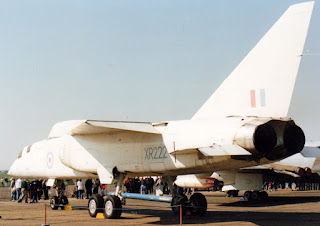 |
| Sverdlov-class cruiser Admiral Ushakov in 1981 |
In some measure of apology to old-time Newsweek, the class namesake of the old Red Navy Sverdlov-class cruisers was commissioned on 15 May 1952, followed by Ordzhonikidize in June, Dzerzhinsky in August, and Zhdanov, Admiral Lazarev, and Aleksandr Nevsky in December. Considering how overweight these 14,000t, 12x6" gun, 3,9" belt ships were by 1952, with so many old gun ships gone to the scrappers, this is quite the naval buildup, and would have been all the more impressive had the Stalingrad-class battlecruisers and proposed aircraft carriers not been scrapped after the death of Stalin on 5 March 1953. This doesn't completely exonerate Newsweek for detecting a battleship long since scrapped on the slips, although there might be some confusion with the Stalingrads, still two years from completion; much less the fantastic idea that the new classes were armed with "rockets."
But as outrageous (and cool)as this story is, this post was inspired by the decades-long undeath of Henry Knowler and the Chief of the Air Staff's incautious comment that two Transport Command Vickers 1002 would all but replace the chartered airlines in Middle Eastern trooping, and, implicitly, far exceed the capacity of the proposed RAF Britannia freighter buy. The Type 1007 was not just cancelled, clearing the way to the subsequent cancellation of the VC7, but the path to its production was swept away by the prior cancellation of the Vickers Valiant 2, the "Pathfinder" type with an improved and stronger wing structure to prevent stress fatigue in low-level operations. This cancellation was explicitly justified by the premise that Pathfinder operations were obsolete, which is dubious to start with, and the implicit one that there was no future requirement for low-level V-bombers. Given that the V-bombers were switched to low-altitude penetration operations only a decade after entering service, and that low-altitude strikes remain an effective and perhaps strategically decisive operational technique today, decades after the V-bombers, but not their B-52 contemporaries, have disappeared, it all seems like almost as much of a comedy of errors as the career of Saro Aircraft.
And, uhm, incredibly enough, that's it. The firm is well known for some crazy prototypes, including a jet flying boat fighter and the incredibobble Princess, but as far as commercial successes go, you've got a small sale of a small helicopter to the British Army and an even smaller one to the Bundeswehr, and the dubious returns of going all-in on the dubious commercial and military potential of the hovercraft.
When I say "incredible," I do not mean that the firm failed to find a market for its dubious products. That sort of thing happens. When I say "incredible," what I mean is that in 1955 the Churchill government handed Saro the British space programme on the strength of their work on a mixed-power interceptor that never got anywhere, either, except to introduce the firm to rocket engines. (Again, a Bundeswehr sale was in prospect. That would have been nice.) Saro worked with Farnborough to produce the BLACK KNIGHT, BLACK ARROW, and BLACK PRINCE, and then Britain became the only country to ever cancel its space programme after getting to space. (Oh, and BLUE STREAK, too.) I'm not, strictly speaking, blaming Saro for this, but when you look at the track record . . .
So what has this to do with over-ambitious Stalinist naval building programmes? Wikipedia, very gingerly, points out that, in 1931, Whitehall Securities Corporation took an interest in Saunders-Roe. It happens that lots of dubious money, or, more plausibly, promises of dubious money flowed into the British aeronautical industry as it emerged from the Depression, and "Whitehall Securities" sure sounds like an implicit promise to competitors to do insider trading better than them. As it happens, the firm turns out to be the investment arm of the Pearson Group, yet another of the giant civil engineering firms entangled with the British Liberal party, and the direct owner of Airwork. The Pearson Group was far from the only company to dabble in the postwar chartered airline business, it turns out. The industry had a lot more pull than you'd expect of a bunch of oil-stained adventurers out of Biggles. And that's before Clan Lines bought Hunting, which bought Airwork. Did you know that the founder of the Cayzer fortune (that is, the family that owns Clan Lines) was the father-in-law of Lord Jellicoe? Crazy!
More important in the long run than some aerodynamic innovations and the FAA's decision to extend the life of the De Havilland engine shop, was the return of the back seater, and therefore of radar-guided strike to British carrier aviation with BLUE PARROT, a development of AIRPASS, the British version of the "fire control system" concept developed for the F-94 and the USAF "1952 interceptors" in general. The English Electric Lightning was well along in development by the spring of 1952 with an integrated Air Data Computer and the AI 23 radar that became AIRPASS; the novelty of BLUE PARROT was that its use as a surface strike radar would lead into terrain-following radar.
No-one anywhere seems to care about boring radars, and the systems behind them barely register, but modern civilisation, and particularly ubiquitous aviation, evidently owes Comrade Stalin at least a moment of gratitude for his late-life decision to play with boats. For one thing, he mobilised enough of a lobby to actually push BLUE PARROT through into service. Given the amount of technology that the Tories managed to kneecap in the course of the Fifties, that's not nothing.



No comments:
Post a Comment